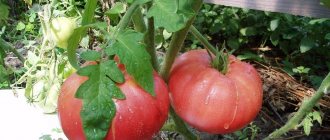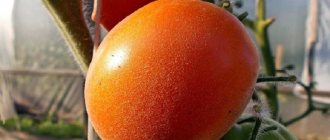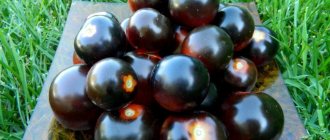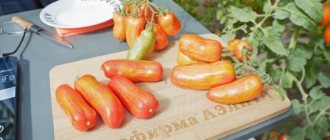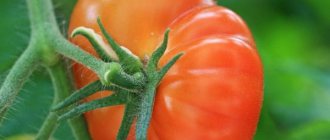Yellow tomatoes have become increasingly popular lately. This is due to the fact that they are much less likely to cause an allergic reaction than red tomatoes. In addition, they are considered healthier due to their increased beta-carotene content. Therefore, it is these fruits that are recommended to be included in the diet of children and adults with vitamin deficiency.
Not all yellow tomatoes are easy to care for and able to grow in open ground in the conditions of our country. Among the abundance of such varieties, the Fairy's Gift tomato stands out. It is frost tolerant and easy to grow.
General description of the variety
The Fairy's Gift is a tomato variety bred by domestic breeders. It was released to the market in 2008.
The variety is included in the State Register of Breeding Achievements. Despite its presence on sale for more than 10 years, it still has not lost its popularity. It is produced by many domestic companies, and it is grown by gardeners around the world.
Distinctive features
The fairy's gift is a yellow-fruited tomato variety. Its fruits are dark yellow or red-orange in color. The shape of such tomatoes is elongated, heart-shaped (see photo).
Tomatoes contain a high concentration of beta-carotene. This substance improves vision and the condition of hair, skin and nails, activates immune processes, stimulates growth in children, and helps eliminate bad cholesterol.
Tomatoes also contain other useful substances: vitamins B, C, K, minerals, pectins, fiber, starch, proteins, organic acids.
The Fairy's Gift is an early ripening variety. Its fruits ripen a little more than three months after sowing the seeds, so the plant does not have time to get late blight.
The variety is also distinguished by its increased resistance to cold. It is grown in all regions of our country. Caring for tomatoes is also not particularly difficult.
The fairy's gift is immune to most diseases of this culture. This reduces the need for chemical treatment.
Characteristics
The Fairy's Gift tomato has suitable characteristics for growing in the climatic conditions of our country. Even novice gardeners can cope with its cultivation.
Fairy Gift Description:
| Parameter | Indicators |
| Bush type | Determinate variety. In open ground, its height reaches 1 m. In a greenhouse, this figure increases by 100 cm. The bush is not standard, it branches slightly. The stem is strong and thick, covered with a medium amount of foliage. The leaves are dark green, medium in size, dissected, without pubescence. The first inflorescence is tied in the axil of the 7-8 leaf. The next ones are two sheets apart. Six ovaries are formed on one plant, 5-8 fruits are formed on each |
| Growing method | Suitable for growing in open ground in the southern and northern regions of our country. In the north, planting in a greenhouse or under film is recommended |
| Productivity | Average: from 1 sq. m, 10 kg of tomatoes are harvested provided they are planted on 1 sq. m six plants |
| Fruit | Average. The weight of one tomato varies between 90-115 g. The tomatoes are dark yellow inside and out. There are specimens of red-orange color. There are no white or green spots at the base inside. The berries have a heart-shaped, elongated shape. Slightly flattened at the base, no pronounced ribbing. The fruits have a sweet taste with barely noticeable sourness. They are meaty but juicy, high in sugars and dry matter. Each tomato has four chambers with a small number of seeds. |
| Transportability | High. The tomato has a tough skin. The variety is suitable for transportation over long distances and long-term storage |
| Ripening time | Early ripening tomato. The harvest ripens 90-100 days after sowing the seeds. Characterized by smooth fruit ripening |
| Disease resistance | Resistant to tobacco mosaic, verticillium wilt and fusarium wilt |
Harvest
This variety, according to the description and reviews, can be grown both in greenhouse conditions and in open ground. Therefore, this tomato variety is grown in different climatic zones.
Varieties of tomatoes (photo)
When grown in the fresh air, the bush reaches a height of about 1 m. If tomatoes are grown in a greenhouse, the height of the bush can be 10 cm higher.
The fruits have the following characteristics:
- have a heart-shaped shape;
- The tomato peel is quite dense;
- ripe tomatoes are reddish in color with an orange tint;
- the weight of each fruit reaches about 100-110 g;
- tomatoes have excellent taste with a slight sweetish aftertaste;
- each bush produces a large number of fruits at the same time;
- fruits can be stored without preservation for a long time.
Thanks to the listed features, this tomato variety has more and more fans every year who want to grow them in their garden plots.
Breeders note the high resistance of the variety to the following diseases:
- TMV or tobacco mosaic virus.
- Wilting tomatoes.
- Fungal disease verticillosis.
With proper and timely care, plant disease can be completely avoided.
Expert opinion
Yulia Yurievna
I have a large garden and vegetable garden, several greenhouses. I love modern methods of cultivating plants and mulching the soil, and I share my experience.
Ask a Question
Growing seedlings
Fairy gifts are often grown using seedlings. This makes it possible to get an earlier harvest.
Seeds are sown for seedlings 55-60 days before planting the plants in a permanent place. Planting dates depend on the region where the crop is grown. In most cases, work begins in the second half of March.
Attention! The fairy gift is also grown without seedlings. In this case, the harvest will not ripen until August.
Seed treatment
Before you start growing seedlings, you need to prepare the seeds. This will help avoid plant infection and speed up the germination of planting material.
When purchasing Fairy Gift seeds, be sure to check the expiration date. Expired planting material has a reduced germination rate.
To check the germination of seeds, soak them in a saline solution (1 teaspoon of salt per glass of liquid).
Disinfect the seeds to prevent the plants from getting sick. There are several options for treating planting material:
- Potassium permanganate solution. The most popular method, which involves soaking the seeds in a solution prepared from 100 ml of water and 1 g of potassium permanganate. After half an hour, the seeds are washed.
- Aloe juice. It is mixed with water in equal proportions. The seeds are soaked in this composition for 12 hours. There is no need to rinse them. The product has the ability to stimulate the germination of planting material.
- Soda solution. Add 1 teaspoon of soda to a glass of water. The seeds are placed in the product for 12 hours. It has stimulating properties.
After treating the seeds, they are soaked in a growth stimulator. Some of the presented compositions with a disinfecting effect can stimulate their germination. If a solution of potassium permanganate is used, the seeds are additionally treated with Epin.
Attention! Some companies produce the Fairy's Gift in an already disinfected form. This is indicated on the packaging. The seeds are colored orange or light green.
Selection of containers and soil preparation
The soil for tomatoes is chosen to be light and nutritious. Suitable mixtures are sold in gardening stores.
They also prepare soil mixtures themselves. The most popular option is peat, humus and black soil mixed in equal proportions. Coconut sawdust, ash and superphosphate are added to the composition.
There is an easier way to prepare soil for tomatoes. In this case, humus and sea sand are mixed in equal proportions.
The prepared soil mixture must be disinfected. There are several methods of disinfection:
- watering the soil with a solution of potassium permanganate;
- watering the soil with boiling water;
- calcination of soil at 100°C;
- cultivation of land with hot steam.
Sowing containers must be large to accommodate a sufficient number of seedlings. Stores sell boxes and trays. Gardeners often use cut-off five-liter bottles, packages from cakes, instant noodles, semi-finished products and disposable tableware.
For picking plants, take 300 ml containers. It is most convenient to use peat pots, but plastic pots and disposable cups will also work.
Sowing planting material
The fairy's gift is usually grown in the usual way. To do this, water the soil in the box generously. Grooves are made in it at a distance of 3 cm from each other.
Seeds are placed in the grooves. A distance of 2 cm must be maintained between them. The planting material is sprinkled on top with a layer of earth that is not compacted.
The containers with seeds are covered with film and placed in a warm place. At this stage, light is not required for plants.
Seedling care
Tomato seedlings Gift from the Fairy require regular care. If you follow all the rules, then no difficulties should arise:
- The seedlings are watered as the soil dries. To do this, use warm, settled water. The main thing is that it does not get on the greenery of the plants. Otherwise they will wither.
- The film is removed from the boxes a week after the seeds germinate. After the first shoots appear, you need to open the film daily to ventilate the plants.
- After the appearance of two true leaves, the tomatoes are dived into separate containers. The plants are carefully removed from the boxes and replanted. It is important to work carefully so as not to damage the roots.
- Tomatoes are fed three times during the entire period of growing seedlings. The first - two weeks after the dive, the second - another two weeks, the last - three days before the landing. For feeding, use vermicompost or complex fertilizers in half the portion specified in the instructions. The last feeding must contain phosphorus.
- Two weeks before picking tomatoes, they begin to harden them. To do this, the seedlings are taken outside, gradually increasing the duration of their stay there.
- The last time tomatoes are watered and fed is three days before planting in the ground.
Growing tomatoes Gift from a fairy
The fairy's gift is planted in open ground when the soil warms up. In the southern regions this happens at the end of April, in the central regions at the end of May, in the northern regions at the beginning of June.
Tomatoes are planted in greenhouses two weeks earlier. It is important not to overexpose seedlings in pots.
Landing in a permanent place
The beds for tomatoes are prepared in the fall. They are cleared of weeds. Organic fertilizers are added to the soil: humus, chicken droppings or cow manure. Soil acidity is checked with litmus paper. If it is elevated, then dry lime is added to the soil.
In the spring, the beds are dug up. Dig holes. For 1 sq. m place no more than six recesses in rows in a checkerboard pattern.
Before planting, the plants are removed from the pots along with a lump of earth. They are placed in the holes, slightly deepened. The holes are covered with earth.
The tomatoes are watered. One plant consumes 1 liter of water. The next time the soil is moistened no earlier than 10 days later.
Tomato care
The fairy's gift bushes need to be shaped. Usually three stems are left. This ensures the best yield while maintaining the size and early ripeness of the fruit.
This variety needs pinching, despite the fact that few extra shoots are formed on the bush. During this procedure, excess leaves in the lower part of the plant are also removed.
The tomato needs a garter. Otherwise, all the fruits will end up on the ground. To do this, use wooden supports or trellises and synthetic thread. Natural fiber will cause the stem to rot.
Water the soil as it dries out. Use 2-4 liters of water per plant. On the day of planting, the soil is not moistened.
After each watering and rain, the soil is loosened. This ensures optimal air exchange in the root system of tomatoes.
Tomatoes are fed every two weeks. It is recommended to alternate organic and mineral fertilizers. Sometimes long-acting complex granules are added to the holes before planting. In this case, during the entire growing season, the plants are fertilized a couple of times with chicken droppings or mullein diluted in water.
Foliar fertilizers should contain boron. Plants are sprayed with such compositions twice.
Nuances of cultivation
Experienced gardeners know a few tricks that will help them get the best harvest. The list contains the most important of them:
- Ugly inflorescences need to be removed. This will allow healthy fruits to form faster.
- After a long drought, you should not water the beds with large amounts of liquid. This will lead to cracking of the fruit. It is better to water them with a small amount of water first, and repeat the procedure a day later.
- Tomatoes need to be shaken regularly to aid pollination. This should be done when the flowers appear.
- Tomatoes should be planted in beds where nightshade crops have not grown before. Potatoes should not be a neighbor of this crop.
- For tomatoes, choose the sunniest area of the garden. This will ensure the best flavor for the fruit.
Diseases and pests
The Fairy Gift variety is resistant to major tomato diseases. Due to its early ripeness, it is rarely affected by late blight .
The immunity of a tomato is not a 100% guarantee that it will never get sick. To reduce the likelihood of infection, you must follow all the rules of prevention.
Not only seeds, soil and planting containers need disinfection. All garden tools that interact with plants are disinfected.
It is important to maintain optimal soil moisture. Following the rules of pinching will help protect tomatoes from diseases.
Some gardeners prefer to spray tomato bushes for prevention. Typically, Fitosporin, copper sulfate and potassium permanganate solution are used.
It is necessary to regularly weed the beds with tomatoes. Weeds carry pathogens and attract pests.
To protect plants from insects, they are treated with soapy water and herbal decoctions (celandine, dandelion, chamomile). Large pests are collected by hand.
How to grow tomatoes
The soil for the beds is prepared in advance, 2 weeks in advance. The soil is dug up and wood ash is added. The holes are made no deeper than 20 cm and filled with warm water.
Landing
Planting pattern: 50 cm - distance between seedlings, 55 cm - row spacing. Transplant into prepared holes in the evening or on a cloudy day when the sun does not shine at full strength. The seedlings are installed vertically and buried down to the first leaves. After transplantation, the holes are compacted and watered with warm water.
Further care of the tomato Gift for a woman
Proper care of a tomato consists of moderate watering and timely application of fertilizing.
Regular watering is established as the seedlings get used to the new conditions. Water 2 times a week in normal weather. On dry or rainy days, watering is carried out as needed. Water only with settled water, at the roots of the plants.
After watering, the soil is loosened and weeds are removed. Weeds not only take nutrients from the soil that are necessary for the full growth of seedlings, but also serve as a good shelter for many pests. Therefore, the proximity of tomatoes to them is undesirable.
To prevent the beds from drying out and remaining moist longer, they are mulched with peat or straw. In addition, mulching protects the beds from ground pests.
Tomato crops are fed at least 3 times during the entire growing season: during flowering, during the formation of ovaries and at the time of fruiting. Feeding is a full complex of minerals or organic matter.
During the flowering period, they are fed mainly with phosphorus substances with the addition of boric acid. And at the time of fruiting, potassium substances are added for faster fruit filling. From organic matter, use mullein infusion or chicken manure in a ratio of 1:10.
Features of care and possible difficulties
The hybrid does not require pinching, which makes caring for it much easier. There are few lateral shoots; they not only do not take away nutrients from the plant, but also do not interfere with receiving the required amount of light. But it is advisable to remove the lower leaves before the first fruitful branch, since with constant contact with wet beds they can rot and provoke an outbreak of fungal infections.
Despite their small growth, the bushes are tied to a reliable support, otherwise the stem will not withstand the weight of the fruit-bearing branches. When transplanting, a wooden or metal support is installed next to each seedling. The stem is fixed immediately after planting in the ground, and the fruitful branches are tied up as they develop.
Advantages and disadvantages of the variety
Benefits of a Fairy Gift:
- early ripeness;
- cold resistance;
- great taste;
- ease of care;
- immunity to major tomato diseases;
- high beta-carotene content.
The variety has no disadvantages, except for some inconveniences during bush formation, pinching and staking.
Plant Formation
The height of the bushes does not exceed 1-1.1 m, however, the Fairy Gift variety is characterized by an abundant ovary, which is the reason for the need to form the plant and tie it to a support.
Experienced vegetable growers recommend feeding a bush with 2-3 stems. The remaining shoots must be pruned. Due to pruning, the maximum number of ovary racemes does not exceed 6 pieces, and the autochoir does not waste energy on the development of a large number of stepsons and barren flowers.
It is prohibited to plant tomatoes in beds after such plants as:
- nightshade;
- eggplant;
- physalis.
In addition, planting tomatoes in one bed for 2 years will hinder their growth and normal development.
Reviews from gardeners
The fairy's gift has good reviews from gardeners who have tried to grow it. Most of them plant it again and again.
Kristina Podolskaya, Tula: “I have been growing the Fairy’s Gift tomato in open ground for several years now. The variety pleases with its unpretentiousness. The fruits are bright orange, heart-shaped. The taste is sweet. The largest specimen I managed to obtain weighed 150 g.”
Gennady Sokolov, Tver: “Last year, for my birthday, I received a gift set of seeds from friends, which also included a Fairy’s Gift tomato. I tried to grow it and was not disappointed. In our climate, very few early-ripening tomatoes can be grown in open ground. And this one has taken root well, despite the not-so-warm weather. I liked the taste of tomatoes. I collected seeds from the fruits and will plant them again.”





